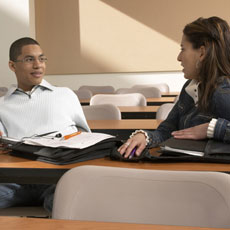The panel discussion is a valuable, time-tested teaching technique used in classrooms of all types to help students understand the experiences of a particular group of people. But it’s not effective in every situation.
As I moved into the graduate classroom as a teacher of students studying higher education I realized I had a short time (one semester) to introduce and expose my students to the vast array of functions in the area of student affairs/student services. My previous experiences facilitating successful panel discussions led me to believe that a panel would be a good method to use here. It was not. In an effort to create a panel that represented a diversity of functions and practitioners, I ended up with too many panelists and, consequently, an ineffective exercise. As the instructor and panel moderator, one has to manage the questions from the class as well as rein in the excitement and enthusiasm of the panel participants to impart their wisdom. A large panel makes that difficult.
I asked the class for feedback following the inclusion of two panel discussions. They loved the panel but wanted to have time to ask more questions and hear more from each person than time allowed. In reflecting upon their feedback, I had an epiphany: speaking directly with others about their work is similar to dating. In dating you have to ask questions to get to know each other and you must have a conversation to learn about the other’s experiences. Then you can decide whether you want to pursue that person… or not!
Employing a speed dating model in the classroom in place of a panel can be an effective way for students to learn a variety of perspectives in a short amount of time. This model improves and enhances student engagement and “creates learning that is active, collaborative, and fosters learning relationships” (Zepke and Leach, 2013).
The design should be intentional and well-thought-out. Here’s how I set up my speed dating model this semester. Twelve pairs of students asked the same questions to twelve different practitioners, essentially receiving twelve different insights on one particular issue in the same amount of time used in a traditional panel discussion. In preparation for this event, students were asked to work in pairs to brainstorm questions for the practitioners/panelists. Each pair turned in a list of three-five questions ranked by their specific interests. As the instructor, I assigned one-two questions per pair. I added follow-up questions to each set so students could delve deeper into the issue if time allowed.
Planning the event requires thought and organization. Prior to the actual event, the questions should be sent to the panelists so they can organize their thoughts. The students in the class should be provided with short biographies for each panelist. Having this information prior to the event will allow the students to use their short time (it is a speed event after all) most effectively. Small touches will make a difference. Providing name tags for everyone, water for the panelists, extra paper and writing instruments for taking notes, and encouraging the professionals to pass out business cards will add to the experience for both parties.
It is important to pay attention to time during the activity. Each round has to be long enough for the students to gather some information and short enough to get to each panelist during the activity. A stopwatch and a whistle are essential equipment.
Most important is to leave time for reflection for the students. At the end of the experience, have students work in their pairs to discuss what they learned. Ask them to synthesize their learning and report to the group their general conclusions. Then, create an opportunity for each student, or pair of students, to share what they learned with the rest of the class. This sharing can be done in class or in a written format, which can be compiled and distributed to the entire class.
The feedback in my class following this activity confirmed for me that this format was a richer learning experience than a traditional panel discussion. One student remarked that she felt they were getting a special backstage pass to connect with professionals in their field. The activity allowed for deep learning and sparked inquiry into the profession that carried throughout the semester.
References:
Feden, P.D. (2012). Teaching without telling: Contemporary pedagogical theory put into practice. Journal on Excellence in College Teaching, 23 (2), 5-23.
Kuh, G., Kinzie, J., Schuh, J., & Whitt, E.J. (2005) Student success in college: Creating conditions that matter. San Francisco, CA: Jossey Bass.
Zepke, N. & Leach, L. (2010). Improving student engagement: Ten proposals for action. Active Learning in Higher Education, 11 (167). DOI: 10.1177/1469787410379680.
Dr. Jacqueline S. Hodes, Assistant Professor and Higher Education/Student Affairs Coordinator, Department of Counselor Education, West Chester University.
(c) 2014 Teach Strats, Magna Publications. All Rights Reserved. Use of any content without permission is strictly prohibited.

